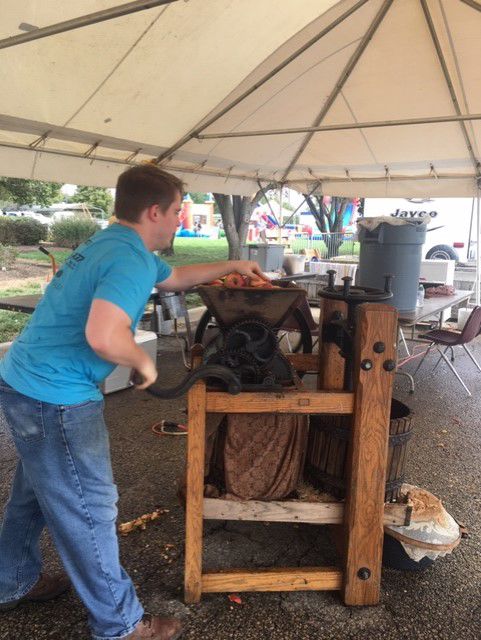Apples transforming into cider
October 1, 2019
What comes to mind when thinking about fall? One answer will not suffice. The crunching of leaves that seem to be hand painted yellow, orange and red? Dreams of haunted houses and Jack the Pumpkin King crawling under the bed?
Cider Days reminds many attendees of that cool and wondrous smelling time of year, and takes place at the Stormont Vail Events Center from Sept. 28 through 29.
Labeled as Topeka’s premier fall celebration for 38 years, according to ciderdaysmarket.com, Cider Days collects 10,000 visitors and features over 250 exhibits including fresh picked apple cider, food, live entertainment, animal attractions and demonstrations.
At the welcome booth, before the entrance to the Stormont Vail Events Center, the Stone family has sold sweet and tangy cider for these two days a year for over seven years. The Stone family took the business over from a family friend.
Kale Stone, one of the sons, describes how to make cider and what tools are useful for creating a sweet and tangy taste that leaves a person wanting more.
“We want to make it as fresh as possible. That’s kind of the showmanship, making it right here in front of everybody. It’s kind of made up in two halves. You dump the apples into this funnel and the apples go down through this mechanism that is spinning these gears by an attachable motor,” said Kale Stone.
The device that Stone describes is the Buckeye Cider Press, which was made in 1865. Storing juice and the process of making fresh apple cider are two different actions.
According to Southern Living, “apple cider is fresh, unfiltered, and often unpasteurized. Juice, on the other hand, is filtered and pasteurized, which gives it a longer shelf life, a sweeter taste, and a smoother texture.”
Because of the lack of sugar and preservatives, the shelf life for the sweet nectar in red solo cups is only a couple of weeks.
“According to the Orchard Guy [Pome On the Range, apple orchard from Ottawa, Kansas] apples are the worst thing in the world to grow,” Stone’s mother, Lori Stone said. “If you get too much rain, that’s not good. If you don’t get enough rain, that’s not good. And this year, because of all the rain, the apple crop was not good. There was a shortage of apples for us to get this year. So we struggled to get enough apples to make cider this year.”
The Stone family will buy one bin of apples for $120 to $150. For Cider Days, the busiest time for apples to be crushed and delivered to the thirsty mouths of thousands, the Stone family will buy about ten of these bins, spending about $1,200 to $1,500.
“We really only do this one event,” said Kale Stone. “One of the biggest rewards, I would say, is just getting to serve all of these people. They all love the cider. It’s just a lot of fun to see them drink it, or the little kids drink it and just be like ‘mmmm, that’s so good.’”
Edited by Jessica Galvin, Adam White, Jackson Woods, Brianna Smith




